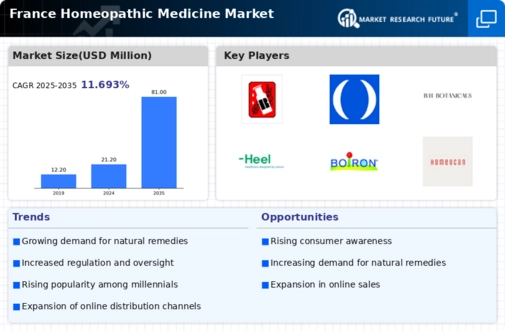The homeopathic medicine market in France exhibits a dynamic competitive landscape characterized by a blend of established players and emerging innovators. Key growth drivers include an increasing consumer preference for natural remedies, heightened awareness of holistic health, and a growing body of research supporting homeopathic practices. Major companies such as Boiron (FR), Schwabe (DE), and Heel (DE) are at the forefront, each adopting distinct strategies to enhance their market presence. Boiron (FR) focuses on innovation in product development, emphasizing the introduction of new formulations tailored to consumer needs. In contrast, Schwabe (DE) appears to prioritize regional expansion, particularly in untapped markets, while Heel (DE) is investing in digital transformation to streamline operations and improve customer engagement. Collectively, these strategies contribute to a competitive environment that is both collaborative and competitive, fostering innovation and responsiveness to market demands.
Key business tactics within this market include localizing manufacturing to reduce costs and optimize supply chains, which is particularly relevant given the increasing demand for rapid delivery of products. The competitive structure of the homeopathic medicine market is moderately fragmented, with several key players holding substantial market shares. This fragmentation allows for a diverse range of products and services, yet the influence of major companies remains significant, shaping consumer preferences and market trends.
In October 2025, Boiron (FR) announced the launch of a new line of homeopathic remedies specifically designed for children, reflecting a strategic move to capture a growing segment of health-conscious parents. This initiative not only diversifies their product portfolio but also positions Boiron (FR) as a leader in pediatric homeopathy, potentially increasing brand loyalty among families seeking safe and effective treatment options. The introduction of these products may also enhance their competitive edge in a market increasingly focused on family health.
In September 2025, Schwabe (DE) expanded its distribution network in Southern Europe, a strategic action aimed at increasing its market penetration in regions where demand for homeopathic solutions is on the rise. This expansion is likely to bolster Schwabe's (DE) presence in a competitive landscape, allowing for greater accessibility of their products and potentially increasing sales volumes. Such regional strategies are crucial for maintaining competitiveness in a market that values local availability and tailored solutions.
In August 2025, Heel (DE) launched a digital platform aimed at enhancing customer interaction and education regarding homeopathic treatments. This move towards digitalization is indicative of a broader trend within the industry, where companies are leveraging technology to improve customer experiences and streamline operations. By investing in digital tools, Heel (DE) not only enhances its operational efficiency but also positions itself as a forward-thinking player in the market, likely attracting a tech-savvy consumer base.
As of November 2025, current competitive trends in the homeopathic medicine market are increasingly defined by digitalization, sustainability, and the integration of artificial intelligence in product development and customer engagement. Strategic alliances among companies are shaping the landscape, fostering collaboration that enhances innovation and market reach. Looking ahead, it appears that competitive differentiation will evolve from traditional price-based competition to a focus on innovation, technological advancements, and supply chain reliability. This shift suggests that companies that prioritize these areas may be better positioned to thrive in an increasingly competitive environment.


















Leave a Comment